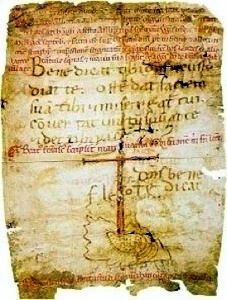Monthly Archives: July 2015
A chartula by any other name…….. (Part 1 – the History)
In going through my research for the period prosperity talisman that I discussed in my last post, I came across the reference to an object called the Chartula of St. Francis of Assisi.
St. Francis was an Italian Catholic friar who lived in the late 12th/early 13th century. Many know him now as the patron saint of animals and the environment. He was an individual who felt greatly with passion his religion, the teachings of the Bible, service to the community and the poor.
It was part of this great devotion to his faith along with his writings that spurred a number of interesting tales of the friar. It was said that he could drive demons away just by the very sound of his voice. He was known to communicate with all the animals of the world when he encountered them. He received the stigmata, which is described in the earliest written account of such.
This last miracle is what leads into my subject of the post, the Chartula.1
St. Francis received the stigmata in the Fall of 1224. The account was recorded by his dear friend and secretary, Brother Leo. Shortly after that incident, Francis felt the need to craft a gift for Leo. It was a protective amulet that he then instructed Brother Leo to fold up and wear on his body at all times. “accipi tipi chartulam itam et usque ad diem mortis tue custodias diligenter”2
This simple act is important for a very particular reason.
It is a solid example of not only the use of a talisman being used by a church man, but accepted as more or less normal. This is understood better by examining writings of contemporaries of St. Francis regarding the nature of talismans and it’s place in the work of God.
In 1266, the Franciscan friar and philosopher, Roger Bacon, created at the request of Pope Clement the IV the Opus majus. In this work he praises the use of textual amulets that utilize the words of God as it showed devotion by the user. told of a time when a shepherd fell into seizures while in the field. A young boy happened upon him and immediately put together a talisman to stop the affliction. The boy tied the talisman to the man’s wrist and instantly the seizing ceased. Bacon reasoned that the talisman worked due “to God’s grace, and not demons, because the boy’s motive had been blameless, free of deception, and thus worthy of divine intervention and blessing.”3
St. Thomas Aquinas in his writings, Summa theologica, condemned astrological talismans as demonic yet allowed talismans that were based on Christian texts.
A century before, there is a well documented account of Hildegard of Bingen crafting a textual amulet to be used to staunch blood.
The Chartula of Assisi is a piece of parchment approximately 5 1/2″ x 4″. On one side is written the Laudes, or praises of God along with brief quotes of scriptures; the other side had written a 5-line benediction chiefly quoting Number 6:24 – 26. Below that was a drawing of a Tau cross on a small mound (assumption is that it is supposed to be Golgotha) with the head/skull of Adam beneath it.
The more refined red writing is that of Brother Leo himself providing small notes about the piece such as the text was written on such a date by Francis, etc.
Upon creating the piece, St. Francis told Brother Leo to take the talisman and to wear it on his person for the rest of his life hoping that it would protect his friend from demons and any attacks, physical or mental. By all accounts he did and upon Brother Leo’s death, the Chartula was preserved in a reliquary and maintained as a focus for prayers, pilgrimages, and at least one exorcism.
When I found out about this amazing artifact, it was something I decided I could actually try and recreate. By doing so, I might be able to better understand some of the thought process that went into it.
The recreation of this piece will be in Part 2.
1 Latin word being the diminutive of charta (paper). Essentially a card or small piece of paper.
2 Don C. Skemer, Binding Words: Textual Amulets in the Middle Ages, 2006, Pennsylvania State University Press, Pg 176
3 Don C. Skemer, Binding Words: Textual Amulets in the Middle Ages, 2006, Pennsylvania State University Press, Pg 62

